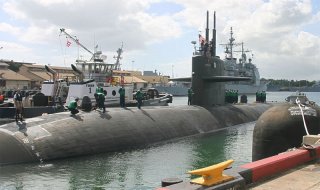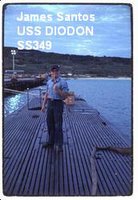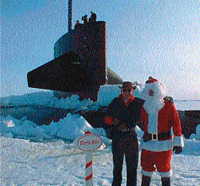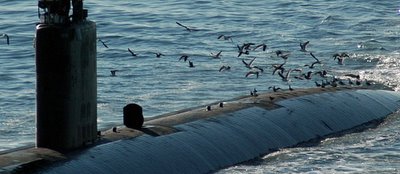Bermuda and Cold War Strategy
Now it has been revealed that the Pentagon probably deployed submarine-killing thermo-nuclear depth bombs on the island of Burmuda,
according to recently declassified 1970 US documents.
"Submarine-launched Soviet ballistic missiles fired from the Bermuda area would have taken only about 16 minutes to strike military and civilian targets along the US East Coast. Soviet submarines were not withdrawn from the Bermuda "patrol box" until the late 1980s. As late as 1987 the Soviet Union engaged in a large-scale submarine exercise near Bermuda involving five vessels which were among the quietest submarines in the Soviet arsenal.The Soviet submarines were so quiet and difficult to detect that nuclear depth bombs dropped from P3-Orion patrol aircraft flying out of Bermuda were thought to be the only assured way of destroying the vessels in the event of the Cold War turning hot."Dr. Henry Kissinger, National Security Adviser to the Nixon White House was involved in secret diplomacy with Brittain to deploy thermo-nuclear weapons in Bermuda. The Brits required existing consultation arrangements extended to cover Bermuda. "By the 1970s, with the Lulu nuclear depth bomb long retired, the Anti-Submarine Warfare weapon deployed in Bermuda would have been
the B57 whose explosive yield ranging from 5 to 20 kilotons," said Dr. William Burr, senior analyst at the National Security Archive project of Washington's Georgetown University, who has studied the declassified documents.
In October, 1986 the Yankee class K-219 got into trouble east of Bermuda with smoke and steam spilling from one of its missile tubes, according to a US P-3 Orion patrol aircraft flying out from the Bermuda US Naval Air Station. On October 6 the K-219 sank, four crewmembers died.
The official cause of the explosion remains unknown. (All emphasis above added by Vigilis. Full article appears at link in first paragraph).
Shrimp Cavitate
Those of us who left active duty before the year 2000 probably missed this sonar tidbit. Although the concept sounds goofy, it is supported well enough in scientific communities to assure winning your next beer bet.
From the start of WWII, researchers studied snapping shrimp. As any submariner knows and many heard firsthand, these "biologicals" create loud, underwater noise. Colonies produce such a din that during World War II, the constant crackling from these shrimp sometimes foiled the military's attempts to find enemy subs.
For years, the assumption had been that the cracking sound occured when the moving part of the shrimp's claw struck its stationary opposite, like castanets. Instead, cavitation--the mechanical process which plagues ships' propellers--is to blame. Cavitation occurs when liquid is forced to move above a certain speed and, as a result, experiences a pressure drop (known as Bernoulli's principle). This phenomenon causes tiny air bubbles in the fluid to swell. As the fluid slows and the pressure again rises, the imploding bubbles generate a shock wave with audible sound.
The little ol' shrimp communicate with one another, defend their territory, and stun their prey with this sound.
For doubters:
here,
here and you more
scientific folk will like the link
here.
Great
article today in the local newspaper about the lengths a Boise native aboard USS Boise (SSN 764) has gone to demonstrate the boat's strong commitment to namesake support, just in time for
tomorrow's BSU-Boston College game here in Boise:
"Lowe is the first native Boisean to serve aboard the USS Boise. Norfolk is the nuclear submarine's home port. Not only are most of the crew's non-New Englanders backing BSU in the game, he said, the Boise's mess (dining room) now has a BSU theme."The crew wanted to jazz it up," he said. "The green 'Great Outdoors' color scheme was replaced with a new blue one, and our Chief of the Boat suggested a BSU football theme to spark and inspire the crew."
"Lowe worked with BSU to get the materials. The result: a blue dining room with orange accents, BSU posters, a Liberty Bowl jersey, a team photo and plaque, a picture of the stadium and a Bronco helmet. Tony Wagster, the sub's supply chief, made a wooden cabinet to display the helmet on a swatch of blue turf. Blue curtains with Bronco logos complete the look."The submarine's hatch cover sports a Bronco logo. Some of the sailors have taken to wearing ball caps with "USS Boise" incorporated into the BSU logo."BZ, MMC(SS) Lowe. I think that anything a crew can do to encourage support for the namesake is a good thing -- this support has a way of coming back to the boat in the form of cool stuff for the crew. The crew's support for the BSU Broncos didn't end in Crew's Mess, though; check out this picture from the article of the boat's diesel:

As you probably guessed, BSU's colors are blue and orange.
(Cross-posted from
The Stupid Shall Be Punished)

Drop on by to the newest submarine website,
Olympia717.com, the official website of the USS Olympia (SSN-717). The boat elected to try an online forum style, a "message board". There's a ship's store, forums, and other features coming online in the next month or so.
And yep, it's my boat.
boat jibes and jabs
i posted something over at
my home blog that got me thinking about the stuff we used to say to each other on the boat. one of my friends remarked once that nukes raised sarcasm to the level of a performing art. taking shots at each other verbally, with particularly cruel ones scoring the highest, was not only common , but required. good training for life, i guess, because it takes a lot to fire me up.
so what were some of the common ones you remember? i'll start with:
- you've got rack burns! this of course was to signify the target was a lazy good for nothing rack hound, spending so much time in the bunk that his face wrinkled like sitting in a tub too long.
- along with #1 above, saying someone was suffering from compression wrinkles was a nicer way to say you spend too much time in the rack, but it's probably due to the length of time at sea, hence under compression, than due to inherent laziness.
- you're nothing but a flob. calling someone a flob, or "free-loading oxygen breather" was just about the nastiest thing you could call someone except:
- if you were a nuke, calling someone a sonar girl was probably the harshest. for nukes, life never ever got easy. many is the time in port when we were doing 12 on 12 off shifts for testing or repairs, and sonar division was only on board for musters and duty days.
so, what do you remember? or for the active duty posters, are these still in use? do you have your own?
curious minds want to know.
oh, and Merry Christmas everybody, and for you kids still on active duty, Thank You from the bottom of my heart.
WINNER! Guess This Former Naval Officer's Identity
UPDATE: Winner is UQNM's own
MT1(SS); Answer (confirmed by
trr) is
Lt. Lafayette Ronald Hubbard, a prolific American author and the controversial founder of
Dianetics and
Scientology.
Not
Lt. Jimmy Carter.
Submarine saga: Hubbard received anti-submarine warfare training. Upon graduating, he commanded subchaser USS PC-815 (in Oregon). When his crew detected what he believed to be
two Japanese submarines near the mouth of the Columbia, Lt. Hubbard attacked the area with 37 depth charges, after which he claimed at least one Japanese submarine had been sunk. The Navy's subsequent investigation concluded Hubbard's vessel had in fact been attacking a "known magnetic deposit" on the seabed, and postwar casualty assessments found no Japanese submarines had been anywhere near the Columbia River at the time. Lt. Hubbard mustered off active duty in 1945. He resigned his commission in 1950.
 Degree of difficulty:
Degree of difficulty: Moderate (only
first answer from each reader will be considered).
Hints: He was an Eagle Scout. Prior to the Navy his studies included Atomic Physics. He held desk jobs before convincing the Navy of his future value as a commanding officer. His aborted naval career included an episode wherein Navy blimps aided an unsuccesssful hunt for submarines. This man achieved national notoriety in the 1970s. The photo was obviously taken later, in civilian life.
First correct answer: Wins ME's
Honorary Naval Historian distinction for 2006, joining
Submandave, winner of
2005's contest.
Through The Teak Wood Cracks

Not a quiz, I haven't a clue to the answer to this one, and finally realized there probably is not a better forum than Ultraquiet to get a reliable answer.
What was the last U.S. submarine to utilize teak wood decking as a working surface? (photo
source)
SSN-575 (commissioned 1957) had it, but don't think she would have been the last one. There were several later boats before the Skipjack (SSN-585) class (launched 1959) which probably ended the practice. Triton (later in 1959) may also have had teak decking (it is not the type thing that is easy to remember).
If you thought that all of the older (than 1957) U.S. subs had teak decking (as I once did) you would be wrong. A link to related, post WWII information has been incredibly elusive to date.
I'm finding all sorts of things today. From the
links page of the
website of the Tullibee Base of USSVI, and thence through the
USS Dioden (SS 349) website (which is a treasure trove in itself), I found the home on the 'net of the
Submarine Research Center. This group of retired submariners sends out
bulletins, one of which is the
elusive foldout picture of my old boat, USS Jimmy Carter (SSN 23), from
Popular Science. The picture itself is pretty humorous (Seawolf-class boats
don't have VLS tubes, and the representation of the propulsor is quite -- inventive, shall we way) but it's still kinda cool.
Anyway, those sites listed above, which are part of the submarine presence on the 'net that exists outside of the sub-blogosphere represented by the "Submariners" blogroll to the right, should provide anyone -- if they're interested -- with hours of fun-filled surfing.
Going deep...
(Cross-posted from
The Stupid Shall Be Punished)
Das Boot
Yes, I know. I'm easily amused. But the smell should be pretty accurate.

Intrigued by the numerous Santa on submarines sighting I ask the question
"Does Santa wear Dolphins?".
Santa Greeting the
USS Hawkbill (SSN 666) at the North Pole.
Cross-posted by Lubber's Line at "
Hundreds of Fathoms".
Update 12/12: New post -
Submariner Santa (SS) Silver and Gold...
Father of Emergency Cooling
[Crossposted from "
Unconsidered Trifles"] Submariners may not recognize the name
Neal Amundson--but they should!
Amundson, often referred to as the "Father of Chemical Engineering" made a crucial contribution to nuclear submarine design: the emergency cooling system.
Among his important intellectual contributions, Amundson was the first person to apply the principles of non-linear mechanics to lumped constant chemical reactor systems, enabling him to explain chemical reactor instability, oscillatory behavior and parametric sensitivity. Amundson also established the field of chemical reactor engineering, being the first to couple reaction with diffusion. With the threat of the essential use of coal, Amundson initiated a systematic and exhaustive development of the gasification of coal char, the products of which would have been used in fuel synthesis. Through this, he realized that the physical geometry of convective natural circulation could be applied to the emergency cooling of nuclear submarines in case of power failure. He constructed a physical and mathematical model and participated in the design of that system in the first nuclear submarine  the Nautilus.
Amundson turns 90 this year and the University of Houston, where he is a professor,
is honoring him with a lecture series.
From one grateful submariner who--no kidding--often marveled at the simplicity of this ingenious system: 'Thank You, Dr. Amundson!'
Submarine Capitol Woes - Tough Taxpayer Choice
Loss of up to 6,000 jobs at Electric Boat within the next three years — 50 percent of current work force will be traumatic for taxpayers in the long run. You had not heard about the
6,000 possibility?
What happens to a C.O.E. (center of excellence) when it undergoes decimation of its workforce?
It reverts to get-by status; talent is lost permanently -and eventually replaced at greater expense.
What is a
COE, you ask? The manufacturer who does it best, satisfies the customer most and at the best available cost. This is accomplished by adoption of best practices in administration, engineering design and fabrication techniques. EB remains this nation's sole submarine shipyard while Newport News produces both nuclear attack submarines and nuclear aircraft carriers.
“If you look at the big picture, we have the best Navy in the world, and the best sailors in the world,” said Capt. Sean Sullivan, the commanding officer of the Groton submarine base. “But we have one small problem: we're not building as many ships.”
"I think what makes it different is that the level of workers is already so low," Groton City Mayor
Dennis Popp said. "We've handled these kinds of cycles before. But when you're down to 11,000 and you're laying off 20 percent, that's substantial." In the last 35 years, EB has seen its work force rise and fall based on submarine production. In its heyday during the 1980s, the company was the region's largest employer with more than 25,000 workers. Throughout the decade, the company's work force held steady. But by the time the 1990s rolled around, the end of the Cold War and submarine production slowing, the company's employment levels begin slipping. They fell dramatically throughout the 1990s, hitting a low point of 9,103 at the start of 2000.
a couple of pearl harbor memories
i posted a little trip down memory lane about pearl harbor over at
the geezer's corner.
anyone else stand watch on the Arizona Memorial? i don't think i'll ever forget that day.
Pearl Harbor + 64: The Submarine Stories
Sixty-four years ago today, the Japanese surprise attack on Pearl Harbor changed the face of World War II and, by bringing the US into the war as a full-fledged Allied power, altered the course of history.
The USS Arizona (BB 39) rests today in the same spot she was in 64 years ago, a permanent reminder of what happened that day, and a stunning memorial to those who lost their lives. As someone who has been fortunate enough to visit the memorial in person, I can only say that no pictures or descriptions do it justice, and I highly recommend visiting it to anyone who has the opportunity to spend some time on Oahu.
The stories of the American submarines at Pearl Harbor are an interesting sidebar to the larger narrative. The
USS Bowfin submarine museum's website has a
page dedicated to the events of Dec. 7, 1941 as told from a submariner's perspective.
The four boats present that day were USS Narwhal (SS-167), USS Dolphin (SS-169), USS Cachalot (SS 170), and USS Tautog (SS-199).
One of the men present that day was Admiral Bernard Clarey, who on December 7, 1941 was Dolphin's XO. The USS Bowfin website has his comments about that day. The stories of Pearl Harbor are singularly awe-inspiring. This is no exception. Here's an excerpt from his recap (my emphasis):
There were four submarines in port that morning, which had arrived two to four days previously from patrols at Midway and Wake. Two of the submarines were given credit along with a destroyer for shooting down one enemy plane. These submarines were undergoing repair and refitting period with some of their machinery dismantled and some removed for ship work. Few naval vessels are more vulnerable to air attack as a surfaced submarine with hatches open and electrical and water lines connected to the shore. Yet the four submarines caught at their Pearl Harbor base gave a good account of themselves that day and in the following four and a half years of the war.
On that fateful Sunday, the submarines of the Pacific Fleet were widely dispersed. Of the 22 which comprised the force, 16 were modern fleet type, up to date submarines. Six others were many years older. There also were 39 submarines in the Far East at the time based in Manila.
Throughout the attack, the officers and crew of the Submarine Base were in the thick of the fight. Those who were not manning guns were rushing ammunition to the gun crews, serving in the Navy Yard with fire fighting details or working with hospital and ambulance crews and rescue parties. Some 1500 blankets and 2000 mattresses were distributed to sailors of the shattered surface fleet. Divers from the escape training tank and the submarine rescue vessel Widgeon rushed to assist in the rescue of men trapped in damaged ships.
The Submarine Base itself did not come under direct attack that morning. In light of subsequent events in the war, the Japanese must have felt many times over that they should have knocked out the Submarine Base and as many submarines as possible.
Indeed. The submarine force was responsible for sinking more than half of all Japanese shipping during the war.
My grandfather,
Edward F. Steffanides was one of the men at Pearl Harbor the day of the attack. He was serving aboard USS Cachalot. Cachalot did what she could to get into the fight that day, as detailed in her
after-action report:
U.S.S. Cachalot
SS170/A16
Serial (C-050) Pearl Harbor, T.H.
December 10, 1941.
From: The Commanding Officer.
To: The Commander-in-Chief, United States Pacific Fleet.
Subject: Raid of December Seventh - Report of.
Reference: (a) Cincpac Conf despatch 102102 of Dec 1941.
1. During period of raid this vessel was moored at Berth 1, Navy Yard, Pearl Harbor, T.H. undergoing scheduled Navy Yard overhaul.
2. Raid commenced at 0755. At 0803 enemy planes passed within range and arc of fire. Opened fire with .30 and .50 caliber machine guns.
3. Between 0845 and 0905 dive bombing and strafing attacks made by enemy. Replied with .30 and .50 caliber machine guns.
4. Between 0945 and 1000 joined in fire against enemy bombers with .30 and .50 caliber machine guns.
5. No positively known damage inflicted upon enemy by this vessel's fire.
6. No material damage received by this vessel.
7. MEYERS, C.A.., S2c, USN received bullet wound in right lung during strafing attack. He was treated at the Navy Hospital. Latest report is that MEYERS is not seriously wounded.
8. Enemy bombing and torpedo attack heavy in vicinity of dock abreast of vessel. Nearest bomb twenty feet off starboard quarter. It did not explode. Nearest torpedo 100 yards astern.
9. Mechanism resembling arming fan for a bomb found on dock abreast of vessel. Threads are metric. Disposition of material - Turned in to CSS 4 Gunnery Officer.
10. The commanding officer was greatly pleased with the composure under fire; ability and energy displayed by his crew during this raid.
[signed]
W.N. CHRISTENSEN.
CC:
COMSUBSCOFOR
CSS 4 - CSD 43
The after action reports for the other subs are also very interesting. You can read them at the links below:
USS TautogUSS NarwhalUSS DolphinThere are many incredible stories about Pearl Harbor. Those are just a few of them.
Never forget.
Cross-posted from The Noonz Wire.
Electric Boat to eliminate up to 2,400 jobs
Breaking news -
Electric Boat to eliminate up to 2,400 jobs this represents 20% of their work force.
Looks like
WillyShake's previous post "
Selling the Sub Force" is very timely.
Selling the Sub Force
(Crossposted from
Unconsidered Trifles)
Bubblehead has an intriguing, thought-provoking posting about the Navy's new shipbuilding "vision". It includes a glimpse as to what might be the
future of the surface navy as well as some grim news for the submarine force.
His post--as well as a conversation with another former submariner visiting for the USNA stampede over Army (LOL)--has got me thinking...
...thinking
some pretty heretical thoughts for a submariner, that is.
Let me just put it out there as a question: What if the submarine force simply looked at the writing on the wall and raised it's hand and said: "You know what? We're not up to the job. Our ability to contribute to the War on Terror, though valuable in some ways, is extremely limited. At the end of the day we admit: you don't need fifty or even forty subs designed to be SEAL delivery vehicles."
The Sub Force would then say (in my hypothetical conversation): "So, we propose instead that you consider very carefully that terrorists are not our only enemies. And that it would be a dire mistake to be caught unguarded against, say, a Chinese naval/submarine threat or another Korean war, or Iran's reconstituted Russian diesel fleet."
Here, then, is my question for my fellow sub bloggers (& admittedly I am undecided how best to respond to this):
Wouldn't it be better if the Sub Force justified its existence based on some other--more traditional, blue-water ASW--threat than to try to be "sexy" for the war on terror?
It'll be gone pretty soon, but for right now the
navy.mil home page has three (!) stories about submarines -- right at the top! For future reference, the stories are about
USS Charlotte's recent trip to the North Pole, USS Chicago's
departure on a deployment, and, at the very top, a throw-away picture of USS Asheville
returning to port.
I started wondering why the Navy would put the picture of the Asheville at the top, in a more prominent place than the other two, seemingly more important, submarine stories. Then it hit me -- there must be more to the photo than I had seen at first glance. Maybe they were trying to send a message to potential adversaries. I went back and looked at the picture of the Asheville, and immediately saw what I had missed. Do you see it?

No? How about in this blow-up of the shot, highlighting the important part:

See it now? The import of this picture in terms of international geo-mili-politics cannot be misunderestimated. This can only be a shot of the B1rD system, CGU-11 mod, in action. The Chinese have nothing like it, as this shot of three Chinese submarines shows -- nary a B1rD in sight. The Navy's clearly trying to send a signal to the Chinese to back off from international troublemaking now... if they don't want to be on the receiving end of the CGU-11's deadly payload (known formally as the "B1rD-p00P Bomb").
 And did you notice the one attached to the rudder? I didn't at first, but here it is:
And did you notice the one attached to the rudder? I didn't at first, but here it is:
I'm just glad that the Submarine Force isn't afraid to invest in the technology needed to keep us a generation or two ahead of our potential rivals. Never can we allow our lead in avian-submarine synergy to lapse. As long as we don't repeat the mistake we made with the "B1rD floating wire install" (where the distant observer would see a straight line of birds sailing along at four knots for no apparent reason), we should maintain our advantage well into this century.
(Cross-posted with minimal editing from The Stupid Shall Be Punished)










